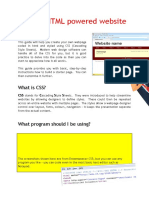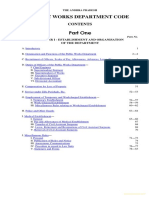0 ratings0% found this document useful (0 votes)
2 viewsBASIC HTML AND CSS
The document provides a comprehensive guide on building a café menu webpage using basic HTML and CSS. It outlines the essential structure of an HTML document, including the use of elements like <head>, <body>, <style>, and <div>, as well as how to style them with CSS. Additionally, it covers best practices for organizing code, linking stylesheets, and using various CSS properties for layout and design.
Uploaded by
Nuno BarrocaCopyright
© © All Rights Reserved
Available Formats
Download as DOCX, PDF, TXT or read online on Scribd
0 ratings0% found this document useful (0 votes)
2 viewsBASIC HTML AND CSS
The document provides a comprehensive guide on building a café menu webpage using basic HTML and CSS. It outlines the essential structure of an HTML document, including the use of elements like <head>, <body>, <style>, and <div>, as well as how to style them with CSS. Additionally, it covers best practices for organizing code, linking stylesheets, and using various CSS properties for layout and design.
Uploaded by
Nuno BarrocaCopyright
© © All Rights Reserved
Available Formats
Download as DOCX, PDF, TXT or read online on Scribd
You are on page 1/ 4
BASIC HTML AND CSS
By building a café menu
Before starting any webpage, we need to follow a basic
structure, every HTML code-based document should start
with <!DOCTYPE html>. This should be followed by the
opening and closing <html> element.
<head>
After the opening statement and html element we can start
coding, The first we want to do is to add a <head>
element, this element is sued for holding meta information
like links or a title.
So, if we want to add a title to our webpage, we should
insert the element <title> nested inside the <head>. Like
this:
The <title> element Is one of several that provide extra
information not visible on the webpage, but it’s useful
for search engines or how the page gets displayed. One of
them is the <meta> element, if we add an attribute named
charset=”utf-8” this will tell the browser how to encode
characters for the page.
NOTE: <meta> is a self-closing element, meaning it doesn’t
need the </>.
<body>
Now we want to add some actual content to the website, for
this we need the <body> element.
The <h1> element is used when we want to really stand out
something on our page, normally we only use it once for
the displayable page title. This goes from h1 to h6.
The <p> element is a simple paragraph, and we use it to
add simple text.
To best organize our code, we can nest similar information
inside one element, so for example I can nest the <h1> and
the first <p> inside a <header> element.
Another famous element in which we nest code is the
<main>, inside the main we can add different <section>.
<style>
Until now we only structured the webpage without any style
to it, to star doing such thing we add the element <style>
nested inside <head>.
Now we choose which element we want to style, and we do
something like this:
When we have too many elements with the same styling, we
can create a list of selectors to make the code easier,
like this:
We have styled these elements by writing CSS inside the
style tags, but in the future, there will be many more
elements to style, so it’s best to put all the styles on a
separate file and link to it.
At the CSS file we repeat the process but in a different
and more organized file.
To style where we want our text we use “text-align” and
give it a position like “center”.
Now that we have our separate file for styling we need to
link it to the html file, we do this by nesting <link
rel=”stylesheet” type=”text/css” href=” styles.css”>
inside the <head> element.
For the styling of the page to look similar on a mobile as
it does on a desktop, we need to add a <meta> element with
a special content attribute. As so:
To change the color of the background we use the
“background-color” and we choose a color.
The <div> element is used mainly for design layout
purposes.
Now everything that is nested inside the <div> can be
styled together.
For example to change the width of all this elements we
simply write:
To comment on CSS we use the “/* */” combination.
The value of width doesn’t need to be in px, we can set it
for a percentage, so for example 80% will make the width
80% of the size of its parent element <body>.
The margins are invisible space around an element, we can
use different margin properties to decide the size of the
margin, or we can set it to auto.
Instead of using the selector like <div> to style elements
we can use a class selector. For this we need to replace
the div for .menu (for example), and then on the html file
add a class=”menu” inside the div.
Background-image lets us use an image a background.
On html, <article> elements commonly contain multiple
elements that have related information, like price and
flavor.
We can give a class to the <article> element so it becomes
easier to style, for example we can style all the <p>
elements with a class named item like this: .item p {}.
To give padding to our elements we use “padding-“ and set
the value in px or percentage. If we want the same padding
on all sides, we just need to write “padding”.
We can add a “max-width” so the elements don’t appear to
far apart on a large screen.
To change the font on all the webpage we use ”font-family”
and set it to a font that the computer recognizes. We can
add a fallback font by adding another font after the first
one, separated by a comma.
To change the style of the font we use “font-style”, we
can set it to italic or bold. To change the size: “font-
size”.
On html we can use <hr> (self-closing) to visually
separate elements. The <hr> element has a border, to alter
the border color we type “border-color”.
We can style a link for it to change color when someone
has already visited it - a:visited – or when someone’s
mouse hovers over – a:hover – or when someone’s click on
it – a:active.
To center a image we use display: block and margin-:auto.
You might also like
- Lecture 0 - CS50's Web Programming With Python and JavaScriptNo ratings yetLecture 0 - CS50's Web Programming With Python and JavaScript1 page
- CSS Worksheet: JMC 105 - Drake UniversityNo ratings yetCSS Worksheet: JMC 105 - Drake University7 pages
- Web Design and Internet Programming Lab Manual (2)No ratings yetWeb Design and Internet Programming Lab Manual (2)18 pages
- CSS Reduces The Number of Tags Used: The Tags We Will Use To Layout The ContentNo ratings yetCSS Reduces The Number of Tags Used: The Tags We Will Use To Layout The Content8 pages
- Unit 3 Lesson 1 Introduction To HTML CSSNo ratings yetUnit 3 Lesson 1 Introduction To HTML CSS38 pages
- HTML + CSS Activity: at The End of The Tutorial, You Will Have Made An HTML File That Looks Like ThisNo ratings yetHTML + CSS Activity: at The End of The Tutorial, You Will Have Made An HTML File That Looks Like This9 pages
- Introduction To HTML-CSS-Javascript (1) - Invert0% (1)Introduction To HTML-CSS-Javascript (1) - Invert45 pages
- CSS Selectors!: Delegating and RefiningNo ratings yetCSS Selectors!: Delegating and Refining21 pages
- 2015 - s2 - WD - Week 10 - Coding Day 18 Page Layout Part 2No ratings yet2015 - s2 - WD - Week 10 - Coding Day 18 Page Layout Part 224 pages
- What Is HTML?: Emphasised Text. This Is A Heading This Is A SubheadingNo ratings yetWhat Is HTML?: Emphasised Text. This Is A Heading This Is A Subheading6 pages
- The Practical Programmer's Guide To HTML & CSSNo ratings yetThe Practical Programmer's Guide To HTML & CSS128 pages
- Mathematics: Quarter 1 - Module 4: Division of FractionsNo ratings yetMathematics: Quarter 1 - Module 4: Division of Fractions32 pages
- Download Complete Brill s Companion to Callimachus Brill s Companions to Classical Studies Benjamin Acosta-Hughes PDF for All Chapters100% (1)Download Complete Brill s Companion to Callimachus Brill s Companions to Classical Studies Benjamin Acosta-Hughes PDF for All Chapters78 pages
- Should You Believe in A Creator? You DecideNo ratings yetShould You Believe in A Creator? You Decide16 pages
- Bringing The Factory Back In: The Crumbling of Consent and The Molding of Collective Capacity at WorkNo ratings yetBringing The Factory Back In: The Crumbling of Consent and The Molding of Collective Capacity at Work23 pages
- Grade 7 1st Worksheet Subttraction of Integers Answer KeNo ratings yetGrade 7 1st Worksheet Subttraction of Integers Answer Ke1 page
- Lesson 1 - Anthropology and The Study of Culture100% (1)Lesson 1 - Anthropology and The Study of Culture71 pages
- 2022-23-CE ANALYSIS OF WATER QUALITY PARAMETERS IN - (5) - Batch-13No ratings yet2022-23-CE ANALYSIS OF WATER QUALITY PARAMETERS IN - (5) - Batch-1351 pages
- Do We Know When and Where We Can Meet Out Spouse Based On Astrology - Quora100% (1)Do We Know When and Where We Can Meet Out Spouse Based On Astrology - Quora141 pages
- DetailsNewCreditAssigned Mar23 OthersecuritiesNo ratings yetDetailsNewCreditAssigned Mar23 Othersecurities16 pages
- Download Complete (Ebook) Oracle Certified Professional Java SE 8 Programmer Exam 1Z0-809: A Comprehensive OCPJP 8 Certification Guide: A Comprehensive OCPJP 8 Certification Guide by Ganesh, SG, Kumar, Hari Kiran, Sharma, Tushar ISBN 9781484218358, 1484218353 PDF for All Chapters100% (8)Download Complete (Ebook) Oracle Certified Professional Java SE 8 Programmer Exam 1Z0-809: A Comprehensive OCPJP 8 Certification Guide: A Comprehensive OCPJP 8 Certification Guide by Ganesh, SG, Kumar, Hari Kiran, Sharma, Tushar ISBN 9781484218358, 1484218353 PDF for All Chapters67 pages
- Grade:: 3Rd Common Core Ms. Jabbari Chadlya Echebbi School Ms Chebbi Aida December 2013No ratings yetGrade:: 3Rd Common Core Ms. Jabbari Chadlya Echebbi School Ms Chebbi Aida December 20134 pages
- 2020-2021 International Exams and Diplomas ListNo ratings yet2020-2021 International Exams and Diplomas List9 pages
- Preboard Examination - 1 Timetable: Class: Ix StateNo ratings yetPreboard Examination - 1 Timetable: Class: Ix State2 pages
- Drug DNA Interaction Protocols 2nd Edition Yang Liu download100% (1)Drug DNA Interaction Protocols 2nd Edition Yang Liu download58 pages
- The Nursing Center A Model For Nursing Practice in The CommunityNo ratings yetThe Nursing Center A Model For Nursing Practice in The Community6 pages

























































































